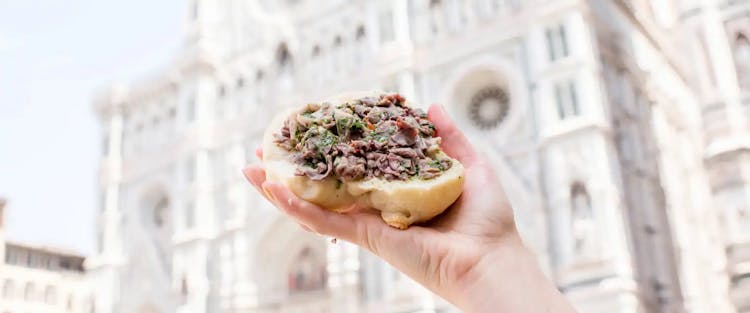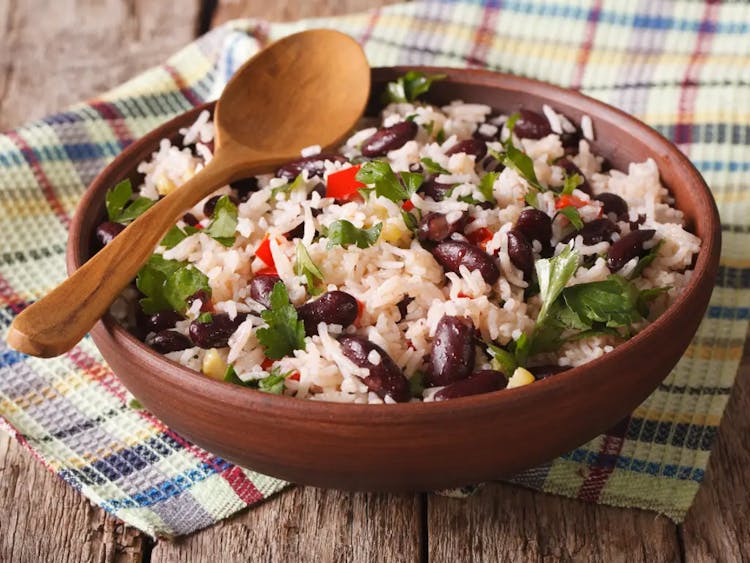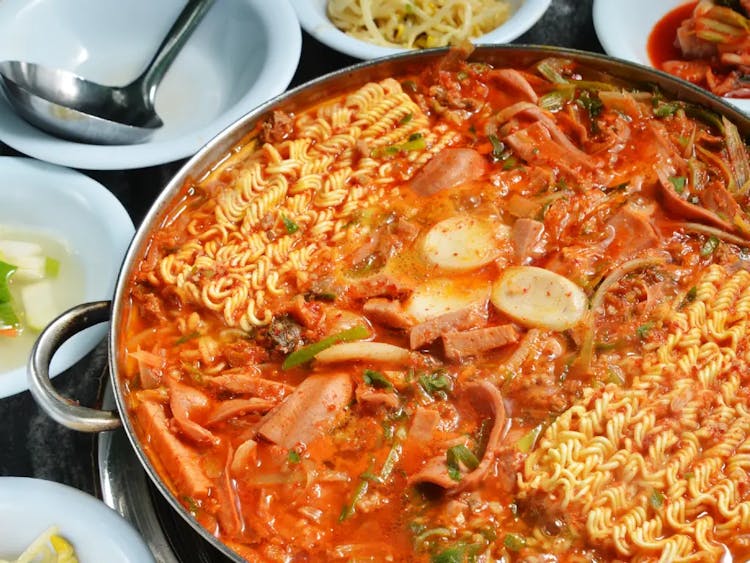
Arepas: The Corn Cake at the Heart of Colombian Cuisine
Just before the first light of day, Cartagena’s street vendors push their carts along the city’s narrow lanes and past brightly-colored buildings, preparing to serve early risers. Those with heavy loads of mangoes and papayas stop under trees in church-filled squares and drop chunks, freshly cut, into small plastic cups. Traffic fumes creep over the high stone walls into the old city, mingling with the smell of fried pastries and sweet lemonade. Some sellers open their giant sun-faded umbrellas, ready for the piercing heat to replace the morning breeze. Slices of watermelon, flasks of sweet coffee, and rows of arepa de huevo are all on display.
“You haven’t really been to Cartagena if you haven’t tried arepa de huevo,” says Marta Delgado, an employee at the popular open-air food joint Fritos Típicos. She grabs a handful of yellow dough from a small mound nearby, flattens and smoothes it between her bare hands, occasionally dipping her fingers in oil to keep the dough from sticking. Delgado has been making arepas for 30 years—and it shows.
Arepas—flattish patties made from a mixture of yellow or white corn flour, water, and a little salt—are common throughout Colombia. The mixture forms a dense dough, which is pressed into small discs and either griddled or fried. In the case of arepa de huevo, the dough is first sliced open and stuffed with a raw egg (and in some places, like Cartagena, also with ground beef). Then the whole thing is only ever fried—even the egg inside.
The arepa de huevo is one of many types of arepas. Served by themselves as a snack or as a side to accompany a meal, they come with an assortment of fillings, such as cheese, sausage, or avocado.
“It’s a typical dish. It’s traditional, and it’s symbolic,” Delgado says as she spoons a few freshly fried, golden arepas from a pot of hot oil into a plastic basket. The smell of fried dough clings to the warm air, reaching my nostrils before the arepa is cool enough to taste. A satisfyingly crispy outer layer gives way to a softer one before the egg and beef—mildly flavored with chili, onion, and cilantro—awaken my tastebuds.

More than just a food
When Spanish conquerors settled in the coastal town of Santa Marta, Colombia, in 1525, arepas were already a staple. Indigenous groups had been incorporating corn into their diets for centuries. While we don’t have an exact date, many studies put arepas at about 3,000 years old—as long as corn has been in Colombia—due to archaeological findings of cooking utensils at sites across Colombia and Venezuela, which were once part of the same territory.
In fact, a friendly rivalry has existed between Colombia and Venezuela for years over which country invented the arepa—and who makes it best. According to historians and writers, such as Miguel Felipe Dorta in his book ¡Viva la arepa!, the word arepa comes from ‘erepa,’ a term that Spanish colonialists documented was used by the Cumanagoto tribe in Venezuela to describe their rounded cornbread. However, many people throughout both countries agree that arepas existed among Indigenous groups long before the Spanish arrived. Although the Spanish didn’t know about arepas before arriving in South America, they apparently took a liking to the snack once there.
For Jaime Rodríguez, a creative development and research chef and founder of Celele Restaurant in Cartagena, the arepa de huevo is an important representation of Colombian history and the four main cultures that exist on its Caribbean coast. “There’s the corn that’s Indigenous, the egg that the Spanish brought, and the frying technique brought by the [enslaved Africans] that came with them,” he says, adding that the addition of spiced meat was a result of Arab immigration during World War II.
The arepa itself is often described as a simple dish, yet the journey from turning corn into arepa dough has historically been quite rigorous. Indigenous women have usually been the ones making the arepas: soaking corn kernels overnight, dehusking them, and drying and grinding them into flour before making a dough with water, shaping them, and cooking them over a fire on a budare, or clay surface.
Although this meticulous preparation is still used today among many Indigenous groups, the invention of pre-cooked corn flour in the 1950s has simplified the process of making arepas, leading it to become a round-the-clock meal inside and outside the home, with more and more small cafes and stands making them and experimenting with different fillings.

One food, many forms
According to Colombia’s tourism board, the arepa is “a meal as varied as the biodiversity of our colorful and vibrant country.” From the simple arepa paisa (a plain griddled arepa without filling) to the creamy and slightly sweet arepa de choclo (made from sweet, yellow corn flour and butter, often topped or filled with white cheese), the tourism board says that more than 40 variations of arepas exist throughout the country.
The reason for such variation: Different communities have different ingredients at their disposal. “In La Guajira, the Indigenous people there make arepas with the middle of the cactus plant,” explains Rodríguez. La Guajira—a remote area in northeast Colombia and home to the Wayuu people—has semi-arid terrain and a lack of infrastructure; the cacti that grow there are often used for food and to build houses. “In Amazonia, they make arepa with yuca,” Rodríguez continues, referring to the Amazon region that is abundant with yuca (cassava root) due to its tropical climate. And in the southern department of Huila in the Magdalena River Valley where rice is one of the main agricultural crops, there are arepas of rice, he says.
His personal favorite is the arepa from Santander, in the mountainous Andes region, which is made with chicharrón (crispy pork belly). Growing up, however, Rodríguez was used to eating a sweeter variety. “I ate arepas with a lot of cheese and honey on top during my childhood,” Rodríguez says. This memory is reflected on his restaurant’s menu with his version of the Samaria arepa, a fluffy arepa with salted cheese from Santa Marta. Rodríguez then drizzles the arepa with sugar cane honey.

Overcoming stereotypes
Despite the significance of the arepa to Colombia, it has largely lacked visibility outside of South America.
A decades-long bloody conflict and the notoriety of drug lord Pablo Escobar meant Colombia had often been associated with violence, drugs, and kidnapping. A peace deal signed in 2016 between FARC guerilla rebels and the government officially brought an end to that conflict, and many Colombians hoped their national image would start to change.
While governments relaxed their travel advisories to Colombia and international tourist numbers started to increase, it was an animated film that many credit with helping turn negative perceptions into more favorable ones. The 2021 release of Disney’s Encanto, set in Colombia, showcased the country’s diverse people, culture—and its food. The main character’s mother had the magical power of being able to heal people with her home-cooked dishes, including arepas.
“It’s a simply wonderful movie,” Myriam Bautista says, as she sits in a corner of Quero Arepa, a 24/7 arepa restaurant owned by her nephew. “And it’s sparked interest among tourists coming in here wanting to try them.” Remembering darker times, Bautista says it’s refreshing to see a positive portrayal of her country.

“Made with love and care”
Back at Fritos Típicos, as the sticky air is replaced by a gentle breeze, I huddle with other customers around the counter. “The arepas here are the best in Cartagena,” an elderly man tells me while my mouth is still full. “They’re made with love and care,” the man, who I find out is named José, says. It’s a beautiful and unprompted comment that lingers as I squirt more spicy sauce (a mix of creamy mayonnaise and chili salsa) onto my arepa de huevo.
Delgado elaborates on José’s words, explaining that it’s not only the finished arepa that’s symbolic but the process too. “Making—and eating—arepas is very special. It’s a way to chat and to share our stories. It’s part of being Colombian. It’s who we are.”

Tips for eating arepas
Arepas are usually eaten with your hands, and you’ll want plenty of napkins for the fried or filled varieties. At street stalls, popular sauces include pineapple salsa or condensed milk, traditionally eaten with cheesy, grilled arepas. With fried arepas, like arepa de huevo, chili sauce or salsa rosada (a mix of ketchup and mayonnaise) are good options. For breakfast, arepas are commonly eaten with a cafe con leche—a sweet milky coffee—or hot chocolate.
Where to eat arepas in Colombia
Cartagena
Locals say Fritos Típicos makes the best arepa de huevo in the city. They are often served with chicha (a corn-based drink) or corozo juice (made from a small red berry-type fruit grown in Colombia’s Caribbean areas).
Dining at Celele is perhaps one of the only times you’ll use a knife and fork to eat an arepa—not only because it’s an upmarket restaurant but because of its rich toppings. Crab from the nearby Archipelago of San Bernardo is made into a rich stew with sweet red chili pepper and served with a thick arepa. Or there’s a portion of the sweet Samaria arepa from nearby Santa Marta.
The menu at this 24-hour restaurant offers an appealing selection. There are arepas with Carribean sausage and cheese. Or ones with fillings of shredded beef, fried plantains, and black beans. Or ones with shrimp in a garlic sauce. And you can get these delivered.
Bogotá
One of the largest food markets in Bogotá, you can find produce, flowers, fish, coffee—and fresh arepas. Eating here is an experience itself, as you’ll find an assortment of arepas—such as the sweet boyacense (made with soft white cheese and sugar) or arepas filled with pork rinds—and be able to savor them in a local and lively atmosphere. (You might even feel inspired to buy some freshly ground corn to make arepas yourself!)
Medellín
With several branches around the city, Las Chachas is a good place to try arepas de choclo, the yellow corn arepas that can be eaten with or without white cheese. The cheese arepas with mozzarella are also a good savory choice.
Join Going to save up to 90% and get cheap flights sent right to your inbox.
Read more about delicious dishes around the world:
Published June 27, 2023
Last updated December 19, 2023
Treat your travel to cheap flights
Most deals are 40-90% off normal prices with great itineraries from the best airlines. If it's not an amazing deal, we won't send it. Sign up for free to start getting flight alerts.




